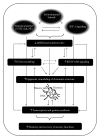IGF-1 restores visual cortex plasticity in adult life by reducing local GABA levels
- PMID: 22720172
- PMCID: PMC3375096
- DOI: 10.1155/2012/250421
IGF-1 restores visual cortex plasticity in adult life by reducing local GABA levels
Abstract
The central nervous system architecture is markedly modified by sensory experience during early life, but a decline of plasticity occurs with age. Recent studies have challenged this dogma providing evidence that both pharmacological treatments and paradigms based on the manipulation of environmental stimulation levels can be successfully employed as strategies for enhancing plasticity in the adult nervous system. Insulin-like growth factor 1 (IGF-1) is a peptide implicated in prenatal and postnatal phases of brain development such as neurogenesis, neuronal differentiation, synaptogenesis, and experience-dependent plasticity. Here, using the visual system as a paradigmatic model, we report that IGF-1 reactivates neural plasticity in the adult brain. Exogenous administration of IGF-1 in the adult visual cortex, indeed, restores the susceptibility of cortical neurons to monocular deprivation and promotes the recovery of normal visual functions in adult amblyopic animals. These effects were accompanied by a marked reduction of intracortical GABA levels. Moreover, we show that a transitory increase of IGF-1 expression is associated to the plasticity reinstatement induced by environmental enrichment (EE) and that blocking IGF-1 action by means of the IGF-1 receptor antagonist JB1 prevents EE effects on plasticity processes.
Figures



Similar articles
-
Experience-dependent reactivation of ocular dominance plasticity in the adult visual cortex.Exp Neurol. 2010 Nov;226(1):100-9. doi: 10.1016/j.expneurol.2010.08.009. Epub 2010 Aug 14. Exp Neurol. 2010. PMID: 20713044
-
Environmental enrichment in adulthood promotes amblyopia recovery through a reduction of intracortical inhibition.Nat Neurosci. 2007 Jun;10(6):679-81. doi: 10.1038/nn1899. Epub 2007 Apr 29. Nat Neurosci. 2007. PMID: 17468749
-
Insulin-like growth factor 1 (IGF-1) mediates the effects of enriched environment (EE) on visual cortical development.PLoS One. 2007 May 30;2(5):e475. doi: 10.1371/journal.pone.0000475. PLoS One. 2007. PMID: 17534425 Free PMC article.
-
Plasticity in the adult brain: lessons from the visual system.Exp Brain Res. 2009 Jan;192(3):335-41. doi: 10.1007/s00221-008-1509-3. Epub 2008 Jul 31. Exp Brain Res. 2009. PMID: 18668231 Review.
-
Plasticity in the visual system: role of neurotrophins and electrical activity.Arch Ital Biol. 2002 Oct;140(4):341-6. Arch Ital Biol. 2002. PMID: 12228987 Review.
Cited by
-
Experience-dependent expression of NPAS4 regulates plasticity in adult visual cortex.J Physiol. 2012 Oct 1;590(19):4777-87. doi: 10.1113/jphysiol.2012.234237. Epub 2012 Jun 6. J Physiol. 2012. PMID: 22674715 Free PMC article.
-
Environmental enrichment causes a global potentiation of neuronal responses across stimulus complexity and lamina of sensory cortex.Front Cell Neurosci. 2013 Aug 8;7:124. doi: 10.3389/fncel.2013.00124. eCollection 2013. Front Cell Neurosci. 2013. PMID: 23964199 Free PMC article.
-
Refinement but not maintenance of visual receptive fields is independent of visual experience.Cereb Cortex. 2015 Apr;25(4):904-17. doi: 10.1093/cercor/bht281. Epub 2013 Oct 9. Cereb Cortex. 2015. PMID: 24108803 Free PMC article.
-
Endocannabinoid and Nitric Oxide-Dependent IGF-I-Mediated Synaptic Plasticity at Mice Barrel Cortex.Cells. 2022 May 14;11(10):1641. doi: 10.3390/cells11101641. Cells. 2022. PMID: 35626678 Free PMC article.
-
Antioxidants Prevent the Effects of Physical Exercise on Visual Cortical Plasticity.Cells. 2022 Dec 22;12(1):48. doi: 10.3390/cells12010048. Cells. 2022. PMID: 36611842 Free PMC article.
References
-
- Katz LC, Shatz CJ. Synaptic activity and the construction of cortical circuits. Science. 1996;274(5290):1133–1138. - PubMed
-
- Berardi N, Pizzorusso T, Maffei L. Critical periods during sensory development. Current Opinion in Neurobiology. 2000;10(1):138–145. - PubMed
-
- Hensch TK. Critical period plasticity in local cortical circuits. Nature Reviews Neuroscience. 2005;6(11):877–888. - PubMed
-
- Wiesel T, Hubel DH. Single-cell responses in striate cortex of kittens deprived of vision. Journal of Neurophysiology. 1963;26:1003–1017. - PubMed
Publication types
MeSH terms
Substances
LinkOut - more resources
Full Text Sources
Medical
Miscellaneous

